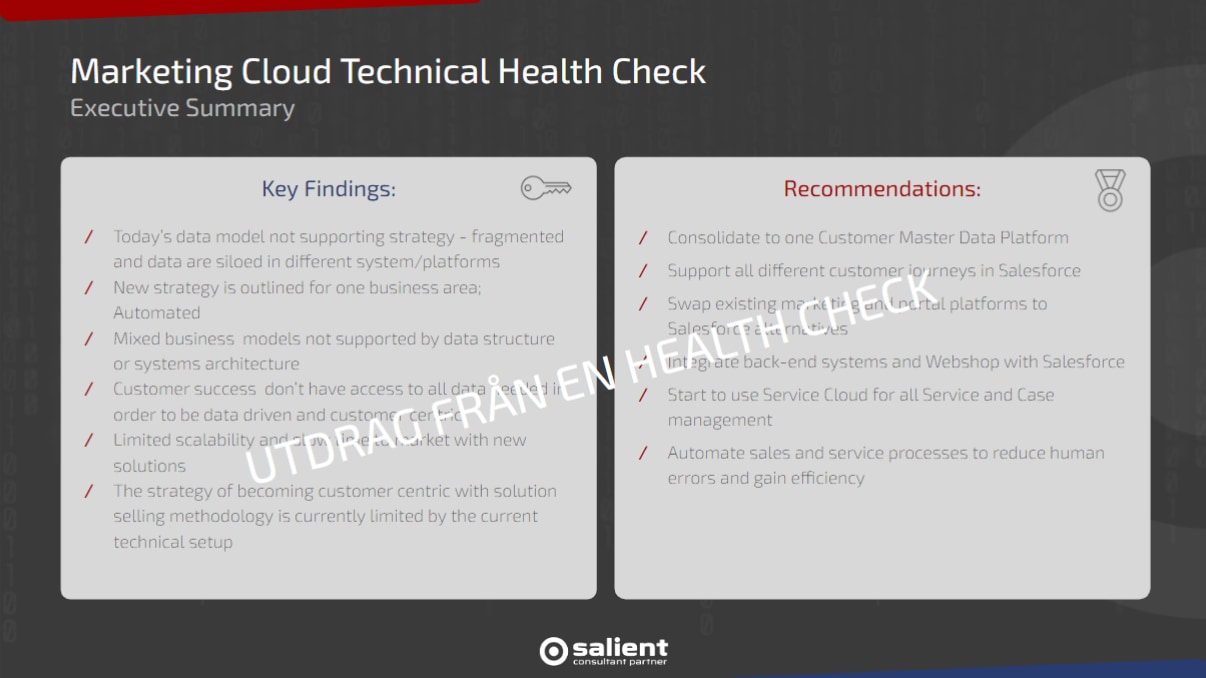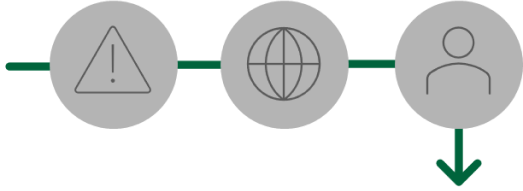If you want help with the above or to identify your current situation and develop a strategy for how you can optimize your Salesforce Marketing Cloud setup, you are most welcome to contact us.
Optimize your Marketing Cloud setup with a free Health Check
Want to find out how your Marketing Cloud setup is doing today? Then it is possible to book a free Health Check with us. This means that for 2 weeks we perform an analysis of your Marketing Cloud setup and identify areas for improvement. One result of the review is a clear action list so you can be sure to capture all opportunities.
How is a Health Check done?

Workshop with relevant people
We do this together

Review of your MC & CRM, creation of Health Check
Salient does this

Presentation of Health Check report
We do this together

Feedback & adjustments
Salient does this

Delivery of Health Check report
Salient does this
How can a Health Check look?
View example of Executive Summary

View example of Scorecard

View example of Email Studio

“Customer quote missing.”
Common questions / FAQ
Common concepts in Marketing Cloud
Data:
- Data Extension:
Tables that store customer data, e.g. contact information, behavior and preferences. - Contacts (Subscribers):
The individuals who are in your data extensions. Contacts are everyone who is in the marketing cloud, while Subscribers are those who explicitly subscribe to receive communications. You can import data from a synchronized data extension to a Subscriber data extension via Marketing Cloud Connect. - Attribute groups:
Organizes data into logical categories within a data extension. - Relationship models:
Determine how data extensions relate to each other. SQL is used to manage data in databases, which gives you more control over your data, streamlines and makes data more scalable so you can adapt it to your specific needs.
Email Marketing:
- Journey Builder:
Visual tool for creating automated email flows. You can also use them for other channels such as push and sms, where you can send automated messages to all contacts in the database, segments of contacts or contacts who perform a specific action. Note the difference between transactional messages and commercial messages. Transactional messages are sent in response to a customer action and often contain information about the transaction. Commercial messages are sent for marketing purposes. With Journey Builder in Marketing Cloud, you can create visual flows that illustrate your customer communications. The flows are based on triggers and events, such as email clicks. You can also set specific goals for each customer journey, e.g. to increase conversion rates or improve customer satisfaction. - Decision Splits:
Conditional branches in automated flows in Journey Builder. - Email Studio:
Tool for creating and sending email campaigns. - Content Builder:
Is an editor for creating beautiful and engaging emails. With Content Builder, you can create emails with dynamic content that adapts automatically to each recipient. This includes AI-based features that can help you choose the right content for each recipient. - AMPscript:
Scripting language for adding dynamic content and functionality to emails.
Tracking and Analysis:
- Marketing Cloud Intelligence:
Built-in analytics tools to track campaign performance. - Web & Mobile Analytics:
Tracks website and app behavior. - Social Studio:
Tracks social media engagement.
Automation:
- Marketing Cloud Automation Studio:
Platform for creating automated campaigns and processes. - Data Entry Events:
This is a powerful feature that allows you to create automated flows based on changes in your data.
Integrations:
- Salesforce CRM:
Salesforce CRM is a powerful platform for managing customer relationships, collecting and analyzing data. Together with the Marketing Cloud, these tools create a sleepless process to streamline and automate the desired customer journey. - AppExchange:
Marketplace for apps and integrations with Salesforce. These apps help you extend the functionality of Salesforce. Up to 40% of all apps are free.
Other important concepts:
- Lead nurturing:
The process of attracting and converting leads into customers. - Marketing Cloud Connect:
Connects Marketing Cloud to other Salesforce products. - Einstein Analytics:
Einstein Analytics is an advanced analytics platform that is part of the Marketing Cloud. It gives you powerful tools to analyze customer data and gain deeper insights into their behavior and preferences.
How can Einstein help me?
Einstein for Marketing Cloud is Salesforce’s AI tool that gives you powerful insights and automation to improve your marketing activities. Einstein helps you to:
Understand your target audience better – Get detailed information about your target audience’s behavior, preferences and demographics. Identify the most relevant segments for your campaigns.
Optimize your sending times – Find the best times to send emails to maximize open and click rates. Automate email scheduling based on individual customer preferences.
Find the right level of engagement – Balance the frequency of your mailings to avoid spam and optimize the customer experience. Get recommendations on how to adapt your communications for different segments.
Create content that resonates – Gain insights into what content performs best and why. Recommendations for optimizing your content for different audiences and channels.
How does Marketing Cloud relate to CRM?
CRM is the platform that acts as a container for all the customer data a business has. MC is a communication platform that, in synchronization with a CRM, can be used for all types of communication to these customers. You can use all data from CRM as long as you integrate with Marketing Cloud Connect.

Melinda
Specialist consultant MC

Johan
Specialist consultant MC

Mari
Specialist consultant MC
“Our internal academy distinguishes our professional development. We continuously certify ourselves in tools and processes, with a special focus on Salesforce.”
Optimize your entire customer journey!
We offer free advice in the form of a digital meeting where we match your conditions and goals with the platform’s potential. Take the first step towards making the most of your Salesforce investment today!
Contact us







